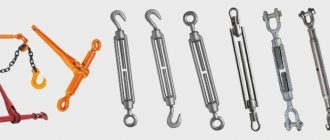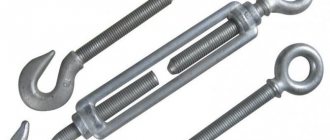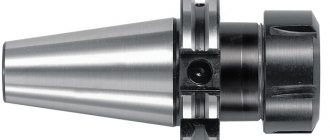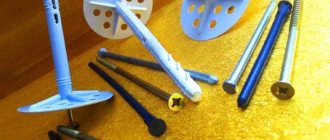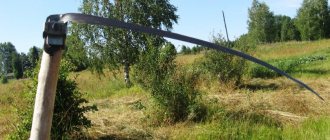If you ask the question what kind of lanyard device this is, few will answer it right away, although such a device has been known and actively used for decades. In many situations, there is a need to tighten ropes, chains, cables or other rigging, which must be done to more securely fix the guy wires. It is not always possible to achieve such a stretch using only your physical strength. It is to solve this problem that lanyards are designed, which we will talk about in this article.
Open type lanyard with ring-ring ends
Lanyard characteristics
Among the main technical and operational parameters, one can highlight the thread diameter, which determines the dimensions of all structural elements. The thicker the rod, the higher the loads the lanyard can handle. The characteristics of the device in terms of diameter are usually expressed in the metric system of measures - in the range from M8 to M20. Average values in specific quantities can be represented by a spectrum from 1/2 to 1 inch. In particular, a product with a 1/2-inch diameter can handle a load of about 680 kg.
The length of the device should also be taken into account. It most often depends proportionally on thickness, but there are exceptions. The average length is 20-50 cm. Again, this value will determine how wide the tension force adjustment range that the lanyard will allow. What is this from an operational point of view? The slinger will be able to control the rigidity of the cable tension through the lanyard mechanism. If, for example, he is handling a 15 cm device, then the range of adjustment will be minimal, while a length of 50 cm will give more options for adjusting the rigidity of the cargo fastener.
Operating parameters of lanyards
For the considered devices with couplings, the main operational characteristics are:
Permissible load. The length of the coupling (less commonly, its transverse dimensions). The length of the lanyard itself with the claws unscrewed (the threaded part does not come out of the coupling body, but completely fills it).
The standard defines an unambiguous relationship between the diameter of the threaded hole in the turnbuckle coupling and its load-bearing capacity. In particular, for stamped couplings the following relationships exist:
- with a load of up to 200 kg - M8;
- with a load of up to 300 kg - M10;
- with a load of up to 500 kg - M12;
- with a load of up to 1200 kg - M16;
- with a load of up to 2000 kg - M20;
- with a load of up to 3150 kg - M24, etc.
The maximum load-bearing capacity of a standard cargo lanyard with an open coupling is 6300 kg; if higher operational loads are required, the rigging is designed and manufactured according to individual orders. Closed turnbuckles are designed for a load capacity of up to 20,000 kg (with the exception of welded coupling structures, the load on which should not exceed 1,500 kg).
The load-carrying capacity of the lanyard is also determined by the type of cargo grip. The lowest permissible values are for hook-to-hook type grips, and the highest are for fork-fork type grips. The design of all components of the lanyard should not have stress concentrators, therefore, when transitioning from one part of the coupling, fork, hook, etc., the maximum possible radius transitions are provided.
The following mandatory requirements apply to standard lanyard designs:
- Strength category after stamping is not lower than KP25 according to GOST 8479;
- Lock nuts must be manufactured in accordance with GOST 5919 using cold heading methods. Thread grooves are not allowed;
- Metric threads on all parts must comply with the requirements of GOST 24705;
- Cast parts must be free of internal and external macrostructure defects (selective quality control must comply with the requirements of RD 34.17.402);
- Welded versions of couplings are performed using E42A electrodes with mandatory cleaning of finished seams.
- Steel lanyards have a surface anti-corrosion coating.
How the lanyard works
Structurally, the lanyard consists of a body (coupling) with multidirectional threads at both ends and two screws with heads. Washers ensure uniform load distribution. To fix the screws at the base of the heads, lock nuts are used to prevent the lanyard from self-unwinding, leading to a weakening of the tension.
The body can be welded or stamped, open or closed, the heads can be in the form of a hook, loop (ring) or fork. The combination of heads on one device can be different: fork-fork, ring-hook, ring-ring, etc.
The tension of the cable is obtained by rotating its body. Since the screws have multidirectional threads: one is right-handed, the other is left-handed, when the housing rotates, both screws either screw in, moving closer to each other and tensioning the cable, or unscrew, moving away and weakening the tension of the cable.
Lanyards are produced in different sizes, designed for different cable diameters and loads.
Performance characteristics of lanyards
The main operational characteristics of lanyards include:
- coupling size;
- the length of the lanyard with heads, when the threaded part does not come out of the body;
- permissible load.
Requirements for lanyard parts
GOST 9690-71 provides the following options for the design of turnbuckle couplings:
Stamped closed couplings. Stamped open couplings. Cast couplings. Welded closed couplings. Welded open couplings.
In closed-type turnbuckles, the threaded part of the load element is completely located in the coupling body. This is considered safer, because if the gripping device suddenly breaks (which most often happens along the thread), its remains do not fly apart. Therefore, the maximum permissible tension force for closed lanyards is always greater than for open ones.
The manufacturing technology of the couplings also largely determines the capabilities of the lanyard. Thus, stamped couplings (the blanks for which are high-quality structural steel according to GOST 1050, steel grade 20 and higher) are strong and reliable. This is explained by the fact that the macrostructure of stamped products does not have cut fibers, and, therefore, there are no stress concentrators. The same is typical for cast couplings, however, the structure of the cast metal is coarser-grained, therefore, other things being equal, the body of a cast coupling will break faster than a stamped one.
Welded couplings have the worst load-bearing capacity: in the weld zone, the strength of the metal is reduced by 20...25% (for the same reason, it is strictly forbidden to restore damaged lanyards by welding).
The standard allows two designs of round turnbuckles: with a through hole in the middle of the body, and without it. In the first case, the conditions for rotation of the housing when tightening are improved, but the cross-section of the coupling is weakened. The starting material for such couplings is seamless steel pipes in accordance with GOST 8734 made of steel 25 (in low-critical turnbuckles, duralumin and ordinary quality steel St. 3 in accordance with GOST 380 can also be used).
For the compactness of coupling lanyards, the diameter of the cargo grips is important. In closed couplings it does not exceed M42, otherwise the coupling becomes heavy and difficult to adjust. Open type couplings do not have such restrictions.
Turnbuckle couplings are manufactured for the following types of grips:
BB (fork-fork). VU (fork-ring). UU (ring-ring). GG (hook-hook). VG (fork-hook). GU (hook-ring).
Rules for using lanyards
The amount of force that acts on the mechanism during operation should not lead to deformation. If this happens, then you need to reduce the force and replace the damaged element. Before work, you need to know exactly the expected weight and select the part based on this. The load should only be along the axis line. Overload is not conducive to normal operation.
The product is not designed for lateral loads. Before use and immediately after, you need to check the fastening for compliance with safety standards, in order to avoid deformation. Before use, it is recommended to thoroughly rinse with gasoline, polish with a felt wheel and apply a protective lubricant containing molybdenum bisulfate and graphite additives. When used in difficult climatic conditions, periodically water with fresh water to wash off the salt. These simple recommendations will help you avoid getting stuck.
If the dimensions, loads are properly observed and maintenance is carried out in a timely manner, the lanyard will last a long time and cause a minimum of problems.
Lanyard device
How to prepare a lanyard
Before you start tensioning the cable, you need to prepare the tool, for which:
- wipe the lanyard with gasoline and polish it with a felt wheel;
- apply lubricant (molybdenum or graphite);
- check the mechanism by running it idle;
- if sea water gets on the lanyard, rinse it with fresh water;
- form a loop at the end of the cable using clamps and pass it through the thimble.
Lanyard selection
Selecting a tool based on the expected load is a guarantee that it will not deform during operation. The tables that the seller has will help you do this, where the manufacturer indicates which model is designed for what. But the choice depends not only on the weight of the load, but also on the function.
The first parameter you need to pay attention to is the thread diameter. Screw fastening for M10, M8, M12, M20, M16, have different threads
The number following the letter “M” indicates the thread diameter in millimeters, M12 is a 12 mm thread. Marking T 10-01, T 30-01 indicates the load at which the part begins to collapse.
Lanyards are most often used when working outdoors, where they are exposed to moisture and temperature changes. Modern parts are not supplied without protection from such exposure; most often this is galvanizing.
What is a lanyard?
With the help of such a simple, but very convenient and reliable device as a lanyard, the performance requirements of which are regulated by the standards DIN 1748, DIN 1480 and GOST 9690-71, it is possible to tension steel cables and keep them taut for a long period of time.
Lanyards used to be called differently: PTR-7-1, and the numbers in their designation varied depending on the model of the device and its technical characteristics. The numbers in the designation, in particular, characterize the magnitude of the destructive load (in tons-force) that a specific model of such a device can withstand. Devices for tensioning cables used earlier did not have such a wide variety of heads as is implemented in modern lanyards. Almost all models of such devices had heads made in the form of oblong loops at their ends, to which steel cables were attached. A little later, the magnitude of the breaking load of a particular lanyard began to be measured in kN. For example, if you decipher the name of the T-30-01 model, it will become clear that such a lanyard can successfully withstand a load of 30 kN, which corresponds to 3 tons-force.
Lanyard options
GOST 9690-71
According to GOST 9690-71, there are the following types of lanyards:
- OS - with open coupling;
- OZ - with a closed coupling;
- ОШ - with a stamped coupling.
Types of lanyards:
- VU - fork-eye;
- BB - fork-fork;
- UU - ear-ear.
Lanyards manufactured in accordance with GOST 9690-71 are used on ships and other floating craft. OSH parts are made of carbon steel, in the following versions:
- VU - fork-eye;
- BB - fork-fork;
- УУ - ear-ear;
- VG - hook fork;
- GG - gak-kak;
- GU - gak-ear.
Lanyard OS are made of magnetic and carbon steels and come in the following versions:
- BB - fork-fork;
- УУ - ear-ear;
- VU - fork-eye.
ZS lanyard is made of steel with a high carbon content and in two types:
- BB - fork-fork;
- VG - fork-hook.
To protect against friction, graphite lubricant is applied to the surface of the rubbing elements. According to GOST, nuts are used to fix the position of the ears (forks). The main purpose of the part is to enhance linear tension. Do not use for lifting loads. When engaging the turnbuckle, there should be no loose turns on the coupling.
Lanyard design
The standard design has three main components. This is a coupling and two threaded rods. The coupling can be closed or open - the choice on this basis depends on the conditions of use of the lanyard. A closed form is required in cases where there is a risk of mechanical damage or coarse sand getting into the mechanism.
The rods at both ends have devices for securing the load - this can be a ring or a hook. Both elements are screwed in from opposite sides along multidirectional threads, which increases the reliability of the mechanism. Usually, the lanyard is attached when it is disassembled. After hooking and fixing the load, the rods are brought together into a coupling with the necessary force. The material for all elements of the device is almost always high-strength stainless steel. Galvanized metal resists moisture, does not corrode and lasts longer under high loads. Another thing is that the formats and standard sizes of the structure can be different.
Manufacturers and prices
Models from domestic manufacturers are predominantly sold in this segment on the Russian market
In particular, the products of Sorokin, Zubr, Crepe-Comp, etc. receive attention from specialists
In terms of cost, the most affordable products are at the level of 300-400 rubles. These are products of small formats, often without special surface treatment at the production cycle stage. In the middle price segment, a lanyard for a cable costs 800-1000 rubles. Such devices are characterized by a high degree of reliability and a variety of configurations. The highest segment represents mechanisms with price tags of about 2 thousand. For this amount you can purchase a large-format lanyard for massive equipment that can withstand tens of tons of cargo.
Production technology
Ring-to-ring lanyard, hook-to-ring lanyard, fork-to-fork lanyard, and hook-to-hook lanyard devices operate under difficult operating conditions. This is due to the fact that when a load occurs, all elements work in tension, sometimes accompanied by bending.
It is also important that the force changes periodically over time, so the reliability and durability of the device also depends on the fatigue limit of the material
Standard sizes of ring-to-ring lanyard according to DIN 1480
The critical element of the drawing is the coupling. As a tensioner, it works under alternating loads. In addition, the frame structure of most standard couplings already contains stress concentrators at the transition points from the side posts to the threaded base. Therefore, these transitions in the drawings are designed in the form of radius curves, the diameter of which is determined by the overall dimensions of the assembled lanyard.
Ring-to-ring lanyard, hook-to-ring lanyard, fork-to-fork lanyard are never produced in welded versions. In addition, it is extremely undesirable to manufacture couplings by casting, even from high-quality structural steels (for example, from casting grade 45L according to GOST 977). The possibility of the presence of internal voids and cavities in the casting remains with any technological production option, which dangerously weakens the cross-section, especially at fastening points. The performance indicators of the milled versions should also be considered not very successful. During the machining process of the parts included in this assembly, the fibers of the metal macrostructure are cut, which reduces durability.
Hot stamping is considered the optimal method for producing parts included in the structure: during its course, plastic redistribution of the volumes of deformed metal occurs, while the fibers bend along the contour, maintaining the strength of the forging. During cold die forging, even hardening of the metal occurs, which makes it possible to produce devices from cheaper grades with a reduced carbon content (for example, from steel 20).
After stamping, the parts are subjected to heat treatment - normalization at 820...860 °C, followed by cooling in air. Quenching is carried out at the same temperatures of heating into oil. The final hardness should be in the range of 190…220 HB. For anti-corrosion protection, a galvanized lanyard is used.
Lanyards
VRH in a closed housing.
| Size | Working load, tons | Breaking force, tn | A, mm | B, mm | C, mm | D, mm | Case length, mm | Weight, kg |
| M6 | 0,2 | 1 | 9 | 18,5 | 4,8 | 175 — 237 | 103 | 0,15 |
| M8 | 0,3 | 1,5 | 9 | 18 | 5,9 | 200 — 290 | 128 | 0,3 |
| M10 | 0,5 | 2,5 | 11,2 | 18,2 | 8 | 235 — 350 | 152 | 0,5 |
| M12 | 0,7 | 3,5 | 18,8 | 30 | 9,5 | 357 — 530 | 237 | 1 |
| M16 | 1,2 | 6 | 19 | 45 | 11,2 | 405 — 540 | 230 | 1,4 |
| M20 | 1,5 | 7,5 | 21 | 39 | 16 | 400 — 548 | 230 | 2,2 |
| M22 | 2,2 | 11 | 23,5 | 39 | 18,6 | 460 — 700 | 305 | 3 |
| M24 | 5 | 25 | 32 | 51,5 | 22 | 575 — 820 | 360 | 4,7 |
| M33 | 7 | 35 | 37 | 64 | 24 | 655 — 920 | 380 | 8,1 |
| M39 | 10 | 50 | 46 | 73,5 | 32 | 715 — 990 | 470 | 11,9 |
| M45 | 13 | 65 | 50,5 | 89 | 36,5 | 775 — 970 | 415 | 18,6 |
| M50 | 17 | 85 | 51,4 | 96 | 43 | 805 — 980 | 413 | 22,6 |
Rigging lanyards
in an open case
| Size metric | Size in inches | Breaking load, tons | Length min/max in mm. | Weight/piece, kg. |
| M6 | 1/4x4 | 0,23 | 200/320 | 0,16 |
| M8 | 5/16x4 | 0,36 | 238/353 | 0,25 |
| M10 | 3/8x6 | 0,54 | 289/441 | 0,37 |
| M12 | 1/2x6 | 0,98 | 330/508 | 0,71 |
| M12 | 1/2x9 | 0,98 | 406/660 | 0,79 |
| M12 | 1/2x9 | 0,98 | 406/660 | 0,79 |
| M12 | 1/2x12 | 0,98 | 482/812 | 1,09 |
| M16 | 5/8x6 | 1,6 | 377/562 | 1,23 |
| M16 | 5/8x9 | 1,6 | 454/714 | 1,56 |
| M16 | 5/8x12 | 1,6 | 530/866 | 1,77 |
| M19 | 3/4x6 | 2,35 | 421/612 | 1,86 |
| M19 | 3/4x9 | 2,35 | 497/764 | 2,48 |
| M19 | 3/4x12 | 2,35 | 574/916 | 2,92 |
| M19 | 3/4x18 | 2,35 | 726/1221 | 3,66 |
| M22 | 7/8x12 | 3,27 | 617/966 | 3,71 |
| M22 | 7/8x18 | 3,27 | 770/1271 | 4,89 |
| M26 | 1x12 | 4,5 | 661/1017 | 5,68 |
| M26 | 1x18 | 4,5 | 814/1322 | 6,87 |
| M26 | 1x24 | 4,5 | 966/1627 | 8,2 |
| M32 | 1 1/4x12 | 6,84 | 750/1118 | 9,34 |
| M32 | 1 1/4x18 | 6,84 | 902/1423 | 11,19 |
| M32 | 1 1/4x24 | 6,84 | 1055/1728 | 12,79 |
| M40 | 1 1/2x12 | 9,7 | 800/1181 | 13,92 |
| M40 | 1 1/2x18 | 9,7 | 952/1485 | 16,67 |
| M40 | 1 1/2x24 | 9,7 | 1104/1790 | 18,45 |
Lanyards DIN 1480
rigging in an open housing.
The practical use of lanyards largely depends on their design. The maximum level of reliability of guy ropes and other elements of cargo equipment is provided by the fork-fork lanyard.
For non-essential operations and household needs the following is used:
ring-ring lanyard
lanyard “hook-ring”
hook-and-hook lanyard
It should be remembered that for the last two, the breaking load of the hook is significantly lower than the ring and body.
| Standard size | Length min/max in mm. | Breaking load, tons | Weight 100 pcs., kg. | |||||
| lanyard hook-ring | lanyard ring-ring | lanyard hook-hook | FRAME | RING | HOOK | lanyard hook-ring | lanyard ring-ring, lanyard hook-hook | |
| M6 | 172/252 | 167/247 | 180/260 | 1 | 0,1 | 0,04 | 9,5 | 9 |
| M8 | 182/257 | 179/254 | 195/270 | 1,2 | 0,2 | 0,08 | 16,5 | 15,5 |
| M10 | 213/298 | 210/295 | 230/315 | 1,5 | 0,5 | 0,15 | 29 | 27 |
| M12 | 238/318 | 230/310 | 250/330 | 2 | 2 | 0,35 | 43 | 41 |
| M14 | 263/353 | 250/340 | 280/370 | 2 | 2 | 0,35 | 62 | 60 |
| M16 | 320/430 | 330/440 | 320/430 | 3 | 3 | 0,7 | 92 | 100 |
| M20 | 367/497 | 335/465 | 400/530 | 4 | 4 | 1 | 163 | 154 |
| M22 | 398/543 | 268/513 | 428/573 | 5 | 5 | 1,5 | 220 | 200 |
| M24 | 447/617 | 420/590 | 490/660 | 6 | 6 | 2 | 300 | 270 |
| M30 | 512/662 | 510/670 | 530/690 | 8 | 10 | 3 | 460 | 435 |
Lanyard selection. Dimensions and specifications
The determining parameter for selection is the operating load, and for lanyards intended for fixing objects in a vertical position, as well as units such as elevators and lifts, such loads are determined with a margin of 600...900%.
For the safety of securing an object or load, the degree of coverage of the lanyard grip by the lanyard is also important. This is especially true for lanyards of the GG type, where the open part of the hook head does not prevent the load from slipping
The safest in this regard are fork-fork lanyards, in which the fastening pin is made of hardened steel and completely covers the hook of the sling.
The approximate maximum loads, depending on the standard size of the thread and the type of cargo grip - fork, eyelet and hook - are respectively, kg:
- for M6 – 100 and 40;
- for M8 – 200 and 80;
- for M10 – 500 and 150;
- for M12 – 2000 and 350;
- for M16 – 3000 and 700;
- for M20 – 4000 and 1000;
- for M24 – 6000 and 2000;
- for M30 – 10000 and 3000.
The choice of ratchet is made according to the chain caliber and its length:
- for 6 mm caliber the maximum load is 4000 kg;
- for caliber 8 mm - 6300 kg;
- for caliber 10 mm - 10,000 kg;
- for caliber 12 mm - 15000 kg;
- for caliber 16 mm - 20,000 kg.
The size and weight of the lanyards are also important. The manufacturer is obliged to certify the lanyards it produces, providing each product with relevant information about the limits of its safe use.
During constant and long-term operation, lanyards are subject to mandatory verification, which is carried out using the technology given in GOST 9690-71.
The price of lanyards depends on their design and load capacity. The price of coupling lanyards is in the range of 400...1500 rubles, ratchet - from 9000 to 16000 rubles.
How to choose the right lanyard
When choosing a device for tensioning a cable, you should be guided, first of all, by the task at hand. Based on it, a specific model and standard size of the lanyard is selected. Ring-to-ring lanyards are used for cables with hooks at the ends, and hook-to-hook or hook-to-ring devices are used to lengthen or tension the cable, for example, on guy wires of masts or antennas or to attach a lanyard to a pole, on in which a fastening element with a ring is installed.
The weight and size of the lanyard and the limits of its safe use must be taken into account. All these parameters are indicated by the manufacturer in the technical specifications of the product. Lanyards are usually made of high-quality steel and have a protective zinc or nickel coating, so they can be used in conditions of high humidity.
Design
The insides of the part are not hidden, so it is more convenient to adjust the tension. The body is made by casting, forging or welding. And the holes for the screws are milled, they regulate the force. For difficult weather conditions, a closed type lanyard is used, which consists of three parts:
- Frame.
- Two screws (left and right thread).
- Screw heads (hook, fork and ring).
Each part of the device is precisely calibrated and will perform a specific function that meets the standards. International documents regulating the technical characteristics and production of lanyards - DIN 1480, DIN 1478. In the territory of the former USSR - GOST 9690-71.
PTR 7-1 lanyards (as these devices were previously called) helped keep steel ropes and cables under constant tension. But they did not have such a large number of heads, unlike modern models. There were oblong loops at the ends. The load for which the lanyard is designed was indicated in the name, based on the ton-force indicator. New models are designated by the parameter in kN. T 30-01, withstands 3 tf or 30 kN.
How to properly tension the cable
For proper operation of the lanyard, you should rotate its body evenly, which will cause the screws to move in opposite directions. The process ends when the cable tension reaches the level necessary to securely fix the object.
When performing tension, you should avoid overloading so as not to deform the lanyard or the tensioned cable. If the tension is too high, you should release it by rotating the lanyard in the opposite direction. It should be remembered that the load should only be axial.
It is recommended to perform the operation using a special torque tool, which allows you to adjust the tension force with great accuracy.
The lanyard can only be subjected to loads for which the tool is designed.
Design and principle of operation of the lanyard
The device in question consists of four parts:
A cast or stamped coupling equipped with two threaded holes. The coupling can be in the form of a rectangular frame or an ellipse. Pairs of hooks or other load-handling elements (slings) with threads on the opposite part. Washers that distribute the load more evenly. Locking nuts that prevent spontaneous rotation of the grips.
A separate group consists of chain lanyards (ratchets), in which the tension occurs not due to the gradual screwing of the grips into the coupling, but due to the twisting of the tension chain located between the load grips. Chain lanyards are used when securing long loads on platforms. It consists of:
Chains (cable tensioner). Two slings. The tension mechanism, which, in turn, includes a ratchet and a shaft on which the ratchet wheel is mounted.
In simple designs of chain lanyards, instead of a ratchet, a lever is provided, the rocking movement of which removes slack in the chain tension.
The necessary fixing force is created due to the rotation of the slings. At the same time, the distance between them is reduced, the gaps are selected, and the tension of the held object between the lanyards is ensured.
Coupling turnbuckles are mainly used in pairs, which allows the tension force to be evenly distributed in the branches of the slings. The chain lanyard can be one-sided. The opposite end of such a lanyard is rigidly fixed to the supporting part of the platform. However, in this case, only the axial component of the tension force is perceived, which is why the ratchet cannot be used for lifting loads or holding objects in a vertical position.
